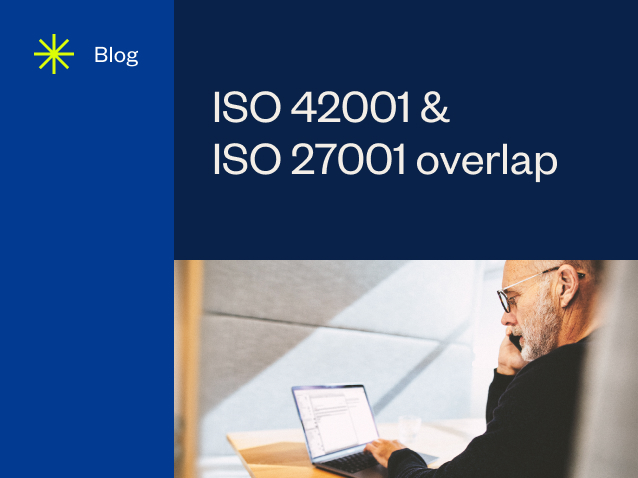The Intersection of ISO 42001 and ISO 27001

Establishing a solid foundation in information security is essential for leveraging artificial intelligence (AI) effectively. ISO/IEC 27001 provides the crucial framework for information security management and sets the groundwork for the new standard for AI, ISO/IEC 42001. By adhering to the principles of ISO 27001, organizations can create robust management systems that not only meet security standards but also pave the way for successful and secure AI implementation. This blog post will explore how ISO 27001 serves as the foundation for ISO 42001, offering a path to compliance.
1. Scope of ISO 27001 and ISO 42001
ISO 27001 focuses on information security management systems (ISMS). It provides a framework to protect sensitive information through risk management processes.
ISO 42001 deals with AI management systems. This standard includes responsibilities specific to AI, such as ethical considerations and impact assessments.
Work required
To align your organization with both standards, build upon your ISMS and create an AIMS. Integrate responsible AI practices to ensure comprehensive scope coverage.
2. Normative references in ISO 27001 and ISO 42001
ISO 27001 references various information security management standards. These guidelines help organizations maintain data integrity, confidentiality, and availability.
ISO 42001 incorporates AI-specific standards, like ISO/IEC 22989. These references focus on ethical AI use, risk management, and system integrity.
Work required
Integrate AI-specific normative references into your compliance framework. Ensure that your organization adheres to both information security and AI-specific standards.
3. Terms and definitions
ISO 27001 includes terms related to information security, such as risk, policy, and controls. These terms are essential for implementing a robust ISMS.
ISO 42001 introduces AI-specific terms, including AI risk, AI policy, and AI objectives. Understanding these terms is crucial for effective AI management.
Work required
Update your organization’s documentation and training materials to include AI-specific terms. This will help employees understand the nuances of both standards.
4. Context of the organization
ISO 27001 requires organizations to understand the context of their information security needs. This involves assessing internal and external factors affecting information security.
ISO 42001 extends this concept to AI. Organizations must understand the specific context of their AI systems, including stakeholder expectations and potential impacts.
Additionally, ISO 42001 requires organizations to understand their role in the AI ecosystem as provider, producer/developer, or user.
Work required
Analyze AI-specific issues and assess stakeholder needs. Document these findings to align with the requirements of both ISO 27001 and ISO 42001.
5. Leadership commitment
ISO 27001 emphasizes leadership commitment to information security policies. Top management must demonstrate their dedication to maintaining a secure environment.
ISO 42001 similarly requires leadership commitment but focuses on AI management. This includes defining roles and responsibilities specific to AI.
Work required
Ensure that your organization’s leadership demonstrates a commitment to both information security and AI policies. Assign roles to manage AI-specific responsibilities effectively.
6. Planning for risks and opportunities
ISO 27001 involves planning to address information security risks and opportunities. This includes risk assessments and treatment plans.
ISO 42001 extends these requirements to include AI risk assessment and impact evaluation. Organizations must identify and mitigate AI-specific risks.
Work required
Implement AI risk and impact assessment processes. Adapt your existing risk management frameworks to include AI-specific considerations.
7. Support resources and competence
ISO 27001 mandates the allocation of resources, competence, and awareness for information security. This ensures effective implementation and maintenance of the ISMS.
ISO 42001 requires similar support for AI management. Organizations must provide resources, training, and communication channels specific to AI.
Work required
Allocate resources for AI management and provide necessary training. Establish communication channels to facilitate information flow regarding AI policies and practices.
8. Operational planning and control
ISO 27001 focuses on operational planning and control for information security. Organizations must have processes in place to manage and monitor security controls.
ISO 42001 extends these requirements to AI systems. This includes planning and controlling AI operations, as well as conducting regular risk and impact assessments.
Work required
Develop operational controls specific to AI systems. Conduct regular assessments to ensure compliance with both ISO 27001 and ISO 42001.
9. Performance evaluation
ISO 27001 requires organizations to monitor, measure, analyze, and evaluate information security performance. This involves regular audits and reviews.
ISO 42001 similarly mandates performance evaluation but with a focus on AI systems. Organizations must establish specific metrics and criteria for AI performance.
Work required
Establish performance metrics for AI systems and conduct regular evaluations and audits. This will help you maintain compliance with both standards.
10. Continual improvement
ISO 27001 emphasizes continual improvement of the ISMS. Organizations must address nonconformities and implement corrective actions.
ISO 42001 also focuses on continual improvement but in the context of AI management. This includes addressing AI-specific nonconformities and applying corrective actions.
Work required
Implement processes for continual improvement of your AI management system. Address nonconformities and apply corrective actions to maintain compliance with ISO 42001 and ISO 27001.
Conclusion
Understanding the overlap between ISO 42001 and ISO 27001 can streamline your compliance efforts. By integrating AI-specific requirements into your existing information security framework, you can ensure comprehensive and efficient management of both systems.
By following the steps outlined in this blog, your organization can stay ahead of the curve with robust security and ethical AI practices. If you need further assistance, experts at A-LIGN can guide you through the compliance process.
